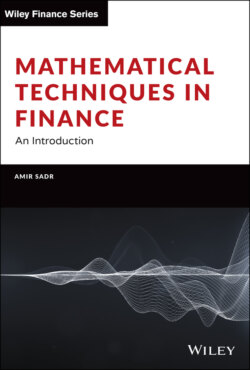Mathematical Techniques in Finance

Реклама. ООО «ЛитРес», ИНН: 7719571260.
Оглавление
Amir Sadr. Mathematical Techniques in Finance
Table of Contents
List of Tables
List of Illustrations
Guide
Pages
Mathematical Techniques in Finance
Preface
BACKGROUND
BOOK STRUCTURE
Bonds
Stocks, Investments
Forwards, Futures
Risk‐Neutral Option Pricing
Option Pricing
Interest Rate Derivatives
Exercises and Python Projects
Acknowledgments
About the Author
Acronyms
CHAPTER 1 Finance
1.1 FOLLOW THE MONEY
1.2 FINANCIAL MARKETS AND PARTICIPANTS
1.3 QUANTITATIVE FINANCE
CHAPTER 2 Rates, Yields, Bond Math
2.1 INTEREST RATES
2.1.1 Fractional Periods
2.1.2 Continuous Compounding
2.1.3 Discount Factor, PV, FV
2.1.4 Yield, Internal Rate of Return
2.2 ARBITRAGE, LAW OF ONE PRICE
2.3 PRICE‐YIELD FORMULA
EXAMPLE 1
2.3.1 Clean Price
2.3.2 Zero‐Coupon Bond
2.3.3 Annuity
2.3.4 Fractional Years, Day Counts
2.3.5 U.S. Treasury Securities
2.4 SOLVING FOR YIELD: ROOT SEARCH
2.4.1 Newton‐Raphson Method
2.4.2 Bisection Method
2.5 PRICE RISK
2.5.1 PV01, PVBP
2.5.2 Convexity
2.5.3 Taylor Series Expansion
EXAMPLE 2
2.5.4 Expansion Around
2.5.5 Numerical Derivatives
2.6 LEVEL PAY LOAN
EXAMPLE 3
2.6.1 Interest and Principal Payments
2.6.2 Average Life
2.6.3 Pool of Loans
2.6.4 Prepayments
2.6.5 Negative Convexity
2.7 YIELD CURVE
2.7.1 Bootstrap Method
2.7.2 Interpolation Method
EXAMPLE 4
2.7.3 Rich/Cheap Analysis
2.7.4 Yield Curve Trades
EXERCISES
PYTHON PROJECTS
CHAPTER 3 Investment Theory
3.1 UTILITY THEORY
3.1.1 Risk Appetite
3.1.2 Risk versus Uncertainty, Ranking
3.1.3 Utility Theory Axioms
3.1.4 Certainty‐Equivalent
3.1.5 X‐ARRA
3.2 PORTFOLIO SELECTION
3.2.1 Asset Allocation
3.2.2 Markowitz Mean‐Variance Portfolio Theory
3.2.3 Risky Assets
3.2.4 Portfolio Risk
3.2.5 Minimum Variance Portfolio
EXAMPLE 1
3.2.6 Leverage, Short Sales
3.2.7 Multiple Risky Assets
3.2.8 Efficient Frontier
3.2.9 Minimum Variance Frontier
EXAMPLE 2
3.2.10 Separation: Two‐Fund Theorem
3.2.11 Risk‐Free Asset
3.2.12 Capital Market Line
3.2.13 Market Portfolio
Example 3
3.3 CAPITAL ASSET PRICING MODEL
3.3.1 CAPM Pricing
3.3.2 Systematic and Diversifiable Risk
3.4 FACTORS
3.4.1 Arbitrage Pricing Theory
3.4.2 Fama‐French Factors
3.4.3 Factor Investing
3.4.4 PCA
3.5 MEAN‐VARIANCE EFFICIENCY AND UTILITY
3.5.1 Parabolic Utility
3.5.2 Jointly Normal Returns
3.6 INVESTMENTS IN PRACTICE
3.6.1 Rebalancing
3.6.2 Performance Measures
3.6.3 Z‐Scores, Mean‐Reversion, Rich‐Cheap
3.6.4 Pairs Trading
EXAMPLE 4
3.6.5 Risk Management
REFERENCES
EXERCISES
PYTHON PROJECTS
CHAPTER 4 Forwards and Futures
4.1 FORWARDS
4.1.1 Forward Price
4.1.2 Cash and Carry
4.1.3 Interim Cash Flows
4.1.4 Valuation of Forwards
4.1.5 Forward Curve
EXAMPLE 1
4.2 FUTURES CONTRACTS
4.2.1 Futures versus Forwards
4.2.2 Zero‐Cost, Leverage
4.2.3 Mark‐to‐Market Loss
4.3 STOCK DIVIDENDS
4.4 FORWARD FOREIGN CURRENCY EXCHANGE RATE
EXAMPLE 2
4.5 FORWARD INTEREST RATES
EXAMPLE 3
REFERENCES
EXERCISES
CHAPTER 5 Risk‐Neutral Valuation
5.1 CONTINGENT CLAIMS
5.2 BINOMIAL MODEL
EXAMPLE 1
5.2.1 Probability‐Free Pricing
5.2.2 No Arbitrage
5.2.3 Risk‐Neutrality
5.3 FROM ONE TIME‐STEP TO TWO
EXAMPLE 2
5.3.1 Self‐Financing, Dynamic Hedging
EXAMPLE 2 (Continued)
5.3.2 Iterated Expectation
5.4 RELATIVE PRICES
5.4.1 Risk‐Neutral Valuation
5.4.2 Fundamental Theorems of Asset Pricing
REFERENCES
EXERCISES
CHAPTER 6 Option Pricing
6.1 RANDOM WALK AND BROWNIAN MOTION
6.1.1 Random Walk
6.1.2 Brownian Motion
6.1.3 Lognormal Distribution, Geometric Brownian Motion
6.2 BLACK‐SCHOLES‐MERTON CALL FORMULA
EXAMPLE 1
6.2.1 Put‐Call Parity
6.2.2 Black's Formula: Options on Forwards
6.2.3 Call Is All You Need
6.3 IMPLIED VOLATILITY
EXAMPLE 2
6.3.1 Skews, Smiles
6.4 GREEKS
6.4.1 Greeks Formulas
6.4.2 Gamma versus Theta
6.4.3 Delta, Gamma versus Time
6.5 DIFFUSIONS, ITO
6.5.1 Black‐Scholes‐Merton PDE
6.5.2 Call Formula and Heat Equation
6.6 CRR BINOMIAL MODEL
6.6.1 CRR Greeks
6.7 AMERICAN‐STYLE OPTIONS
6.7.1 American Call Options
6.7.2 Backward Induction
6.8 PATH‐DEPENDENT OPTIONS
6.9 EUROPEAN OPTIONS IN PRACTICE
REFERENCES
EXERCISES
PYTHON PROJECTS
CHAPTER 7 Interest Rate Derivatives
7.1 TERM STRUCTURE OF INTEREST RATES
7.1.1 Zero Curve
7.1.2 Forward Rate Curve
7.2 INTEREST RATE SWAPS
7.2.1 Swap Valuation
EXAMPLE 1
7.2.2 Swap = Bone − 100%
7.2.3 Discounting the Forwards
7.2.4 Swap Rate as Average Forward Rate
7.3 INTEREST RATE DERIVATIVES
7.3.1 Black's Normal Model
7.3.2 Caps and Floors
EXAMPLE 2
7.3.3 European Swaptions
EXAMPLE 3
7.3.4 Constant Maturity Swaps
7.4 INTEREST RATE MODELS
7.4.1 Money Market Account, Short Rate
7.4.2 Short Rate Models
7.4.3 Mean Reversion, Vasicek and Hull‐White Models
7.4.4 Short Rate Lattice Model
7.4.5 Pure Securities
7.5 BERMUDAN SWAPTIONS
EXAMPLE 4
7.6 TERM STRUCTURE MODELS
7.7 INTEREST RATE DERIVATIVES IN PRACTICE
7.7.1 Interest Rate Risk
7.7.2 Value at Risk (VaR)
REFERENCES
EXERCISES
APPENDIX A Math and Probability Review. A.1 CALCULUS AND DIFFERENTIATION RULES
A.1.1 Taylor Series
A.2 PROBABILITY REVIEW
A.2.1 Density and Distribution Functions
A.2.2 Expected Values, Moments
A.2.3 Conditional Probability and Expectation
A.2.4 Jensen's Inequality
A.2.5 Normal Distribution
A.2.6 Central Limit Theorem
A.3 LINEAR REGRESSION ANALYSIS
A.3.1 Regression Distributions
APPENDIX B Useful Excel Functions
About the Companion Website
Index
WILEY END USER LICENSE AGREEMENT
Отрывок из книги
Founded in 1807, John Wiley & Sons is the oldest independent publishing company in the United States. With offices in North America, Europe, Australia and Asia, Wiley is globally committed to developing and marketing print and electronic products and services for our customers' professional and personal knowledge and understanding.
The Wiley Finance series contains books written specifically for finance and investment professionals as well as sophisticated individual investors and their financial advisors. Book topics range from portfolio management to e‐commerce, risk management, financial engineering, valuation and financial instrument analysis, as well as much more.
.....
Moving from equilibrium results, we next introduce statistical techniques such as regression, factor models, and PCA to find common drivers of asset returns and statistical measures such as the alpha and beta of portfolio performance. Trading strategies such as pairs trading and mean‐reversion trades are based on these methods. We conclude by showing the use of recurrence equations and optimization techniques for risk and money management leading to the gambler's ruin formula and Kelly's ratio.
In Chapter 4, we introduce the forward contract as the gateway product to more complicated contingent claims and options and derivatives. The basic cash‐and‐carry argument shows the method of static replication and arbitrage pricing. This method is used to compute forward prices in equities with discrete dividends or dividend yields, forward exchange rate via covered interest parity, and forward rates in interest rate markets.
.....